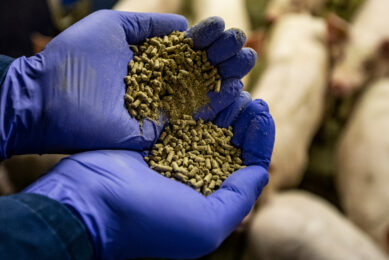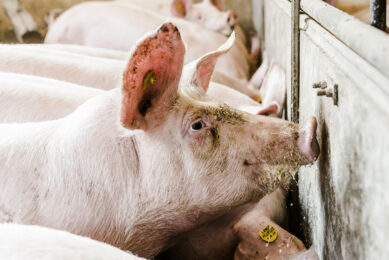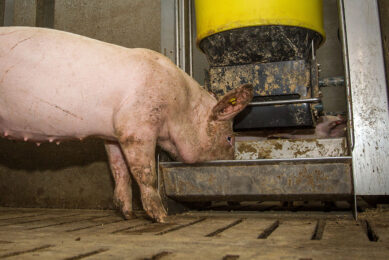Seaweed and clay, a new feed combination

Seaweeds are being increasingly explored for their nutritional, structural and biological properties. Research has identified a type of seaweed extract that is being used in combination with micronized montmorillonite for its capacity to improve feed efficiency.
Seaweeds, or macroalgae, are eukaryotic and pluricellular organisms, divided into three different groups: green, red and brown. They contain a variable part of carbohydrates (mainly polysaccharides), proteins, minerals, lipids and vitamins. French animal nutrition company, Olmix specialises in the identification, characterisation and extraction of specific seaweed extracts from green, red and brown algae, focusing mainly on the extraction of seaweed polysaccharides.
Nutritional studies on marine algae indicate that green, brown and red seaweeds possess good nutritional characteristics and could be used as an alternative source of dietary fibre, protein, vitamins and minerals. In addition, detailed screening of macroalgae functions revealed that they contain high level of diverse metallic ions (iron, zinc, copper, titanium, etc.) which act as cofactors of enzymes and favour their efficacy. Cofactors are defined as thermostable compounds that form the active portion of an enzyme system. In other words, cofactors are helper molecules required for enzymes to be active. They can be inorganic such as metallic ions. Thereby, copper is known to activate lipase and phospholipase A and zinc is a required cofactor of carboxypeptidase, to mention only a few examples. In summary, seaweeds bring in many diverse metallic ions, sometimes absent in the feed, which are required cofactors for the activation of several enzymes.
The substitution phenomenon
Clays are layered mineral materials, composed of a succession of aluminium and silica based sheets, which order varies according to the type of clay. In montmorillonite, several metallic ions replace some aluminium and silica ions in the structure. Known as the substitution phenomenon, this event provides montmorillonite part of its physico-chemical reactivity. As for seaweed, the presence of metallic ions may also contribute to the activation of some enzymes, through their action of cofactors. Older studies suggest that the increased activity of enzymes in contact with clay not only comes from the presence of cofactors but from their stabilisation.
The dominant hypothesis described in the literature is that clays slow down the transit of feed in the intestine, so the time for digestion is increased, hence a better digestibility of feeds and nutrients uptake. Such effect has been described for growing pigs, when supplementation with clay increased their speed of growth between 25 and 106 kg and improved their carcass quality (higher lean meat). Weight gain and feed efficiency of broilers has also been improved when the feed was supplemented with Montmorillonite. In both studies, the stressed mode of action was a decrease in transit speed. Nevertheless, it seems that the action of clays to enhance feed digestion in the intestine involves other mechanisms. Reichardt (2008) and Habold et al (2009) both report the ability of clays to favour the contact between enzymes and nutrients, and therefore to improve the rate of digestion of the feed.
A good supporting matrix for enzymes
Indeed, digestive enzymes need to be in contact with their substrate for hydrolysis to occur. The physico-chemical interactions of the enzymes with clay particles seem to enhance the contact between the digestive enzymes and the feed, making clays a good supporting matrix for enzymes and acting as a meeting point for them to be in contact with their substrate. Moreover, Cabezas et al (1991) demonstrated that clay-enzymes complexes are formed at enteric pH values. These active stable complexes are resistant to proteolysis and increase the amount of active digestive enzymes in the intestine, thus improving nutrient digestibility. Micronisation is a specific process that allows a fine dispersion of the montmorillonite in the intestine, in order to increase the number of sites of reaction of enzymatic digestion comparing to a standard montmorillonite.
Olmix technology first use a micronized montmorillonite produced thanks to a specific drying and ball milling process. This specific micronized montmorillonite is then complexed with green and red seaweed extracts for their high content in rare metallic ions. The final combination of seaweeds and micronized montmorillonite leads to a unique tool to boost enzyme activity through the action of biocatalysis. MFeed+, is the only product benefiting from this innovative technology and has proven its efficacy in several trials.

Efficacy studies across species
The first study implemented to validate the efficacy of this new technology on monogastric was conducted by INRA Saint-Gilles (French National Institute for Agronomic Research). The product was successful in improving the ileal digestibility performance of growing pigs. When compared to the standard diet, the MFeed+ diet presented a significantly increased apparent ileal digestive utilisation coefficient (%) of gross energy (GE), dry matter (DM) and organic matter (OM), respectively being (+3.4%, P ≤ 0.05), (+3.4%, P ≤ 0.01), (+3.1%, P ≤ 0.01). The product-fed diet also showed significantly increased standardised ileal digestive utilisation coefficient (%) for non essential amino acids (+3.8%, P ≤ 0.01), lysine (+3.6%, P ≤ 0.01) and threonine (+5.3%, P ≤ 0.01).
In a poultry study conducted by an independent research centre on a conventional farm in France, the product was successful in improving the performance of broilers fed a corn-wheat based diet using by-products. Growth performance was increased by 7% in comparison with non-supplemented diets for the whole period (+ 12% in finishing phase), and was equivalent to the growth rate observed on broilers fed a standard corn-wheat based diet. Investigators thus highlighted the interest of using MFeed+ in diets using by-products, as a way to decrease the feed cost. With by-products like corn DDGS being more and more present on the market, though not used widely because of their nutritional profile, such an outlet is a great prospect for managing feed costs while ensuring optimum performance of the feed.
In another experimental study conducted in a Midwest feed company’s research centre in the US, the product also proved its capacity to improve performance of broilers. The study was run on corn-soy based feed and also contained cereal by-products: 9% wheat middling, 3% corn gluten meal and 2% corn DDGS in the starter feed and 9% corn DDGS in the grow-to-finish feed. Both feeds contained several digestibility enhancers, including a protected butyric acid and different enzymes (phytase, xylanase, protease and amylase). In this study, the growth rate of the group fed the product was higher in all phases in favour of the test group (+1.4% in average) and feed efficiency was improved by 1.6% on average. The improved performance resulted in a positive return on investment of 2:1.
Lately many commercial trials under different conditions worldwide have confirmed the efficacy of the product to improve feed efficiency. It appears to be a great prospect to manage feed efficiency ensuring optimum performance of the feed particularly in the presence of challenging raw materials such as by-products.
References available on request
Local regulations should be consulted concerning the status of this product in the country of destination. All information only for export outside Europe, USA and Canada.






